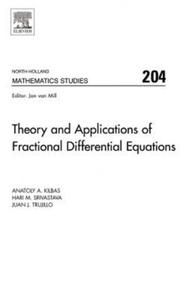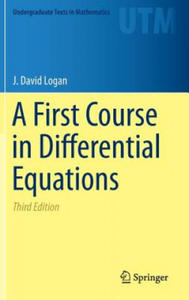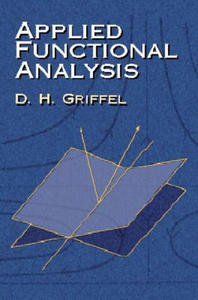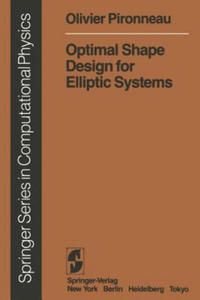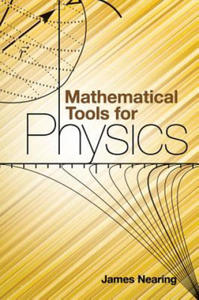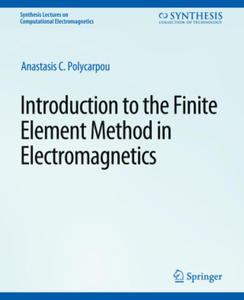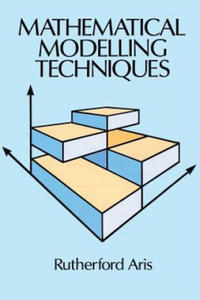libristo partial differential equations vol 2 5273866
- znaleziono 16 produktów w 4 sklepach
Theory Of Differential Equations, Vol. 2 (Classic Reprint)
Książki Obcojęzyczne>Nieprzypisane
0x0012186500000000
Sklep: Gigant.pl
Theory and Applications of Fractional Differential Equations Elsevier Science & Technology
Książki / Literatura obcojęzyczna
This monograph provides the most recent and up-to-date developments on fractional differential and fractional integro-differential equations involving many different potentially useful operators of fractional calculus. The subject of fractional calculus and its applications (that is, calculus of integrals and derivatives of any arbitrary real or complex order) has gained considerable popularity and importance during the past three decades or so, due mainly to its demonstrated applications in numerous seemingly diverse and widespread fields of science and engineering. Some of the areas of present-day applications of fractional models include Fluid Flow, Solute Transport or Dynamical Processes in Self-Similar and Porous Structures, Diffusive Transport akin to Diffusion, Material Viscoelastic Theory, Electromagnetic Theory, Dynamics of Earthquakes, Control Theory of Dynamical Systems, Optics and Signal Processing, Bio-Sciences, Economics, Geology, Astrophysics, Probability and Statistics, Chemical Physics, and so on.In the above-mentioned areas, there are phenomena with estrange kinetics which have a microscopic complex behaviour, and their macroscopic dynamics can not be characterized by classical derivative models. The fractional modelling is an emergent tool which use fractional differential equations including derivatives of fractional order, that is, we can speak about a derivative of order 1/3, or square root of 2, and so on. Some of such fractional models can have solutions which are non-differentiable but continuous functions, such as Weierstrass type functions. Such kinds of properties are, obviously, impossible for the ordinary models. What are the useful properties of these fractional operators which help in the modelling of so many anomalous processes? From the point of view of the authors and from known experimental results, most of the processes associated with complex systems have non-local dynamics involving long-memory in time, and the fractional integral and fractional derivative operators do have some of those characteristics.This book is written primarily for the graduate students and researchers in many different disciplines in the mathematical, physical, engineering and so many others sciences, who are interested not only in learning about the various mathematical tools and techniques used in the theory and widespread applications of fractional differential equations, but also in further investigations which emerge naturally from (or which are motivated substantially by) the physical situations modelled mathematically in the book. This monograph consists of a total of eight chapters and a very extensive bibliography. The main objective of it is to complement the contents of the other books dedicated to the study and the applications of fractional differential equations.The aim of the book is to present, in a systematic manner, results including the existence and uniqueness of solutions for the Cauchy type problems involving nonlinear ordinary fractional differential equations, explicit solutions of linear differential equations and of the corresponding initial-value problems through different methods, closed-form solutions of ordinary and partial differential equations, and a theory of the so-called sequential linear fractional differential equations including a generalization of the classical Frobenius method, and also to include an interesting set of applications of the developed theory. It is mainly application oriented and it contains a complete theory of Fractional Differential Equations. It can be used as a postgraduate-level textbook in many different disciplines within science and engineering and it contains an up-to-date bibliography. It provides problems and directions for further investigations. Fractional Modelling is an emergent tool with demonstrated applications in numerous seemingly diverse and widespread fields of science and engineering. It contains many examples.
Sklep: Libristo.pl
First Course in Differential Equations Springer International Publishing AG
Książki / Literatura obcojęzyczna
The third edition of this concise, popular textbook on elementary differential equations gives instructors an alternative to the many voluminous texts on the market. It presents a thorough treatment of the standard topics in an accessible, easy-to-read, format. The overarching perspective of the text conveys that differential equations are about applications . This book illuminates the mathematical theory in the text with a wide variety of applications that will appeal to students in physics, engineering, the biosciences, economics and mathematics. Instructors are likely to find that the first four or five chapters are suitable for a first course in the subject.§§This edition contains a healthy increase over earlier editions in the number of worked examples and exercises, particularly those routine in nature. Two appendices include a review with practice problems, and a MATLAB
Sklep: Libristo.pl
Introduction To Differential Geometry - With The Use Of Tensor Calculus Read Books
Książki / Literatura obcojęzyczna
AN INTRODUCTION TO DIFFERENTIAL GEOMETRY WITH USE OF THE TENSOR CALCULUS By LUTHER PFAHLER EISENHART. Preface: Since 1909, when my Differential Geometry of Curves and Surfaces was published, the tensor calculus, which had previously been invented by Ricci, was adopted by Einstein in his General Theory of Relativity, and has been developed further in the study of Riemannian Geometry and various generalizations of the latter. In the present book the tensor calculus of cuclidean 3-space is developed and then generalized so as to apply to a Riemannian space of any number of dimensions. The tensor calculus as here developed is applied in Chapters III and IV to the study of differential geometry of surfaces in 3-space, the material treated being equivalent to what appears in general in the first eight chapters of my former book with such additions as follow from the introduction of the concept of parallelism of Levi-Civita and the content of the tensor calculus. LUTHER PFAHLER EISENHART. Contents include: CHAPTER I CURVES IN SPACE SECTION PAGE 1. Curves ami surfaces. The summation convention 1 2. Length of a curve. Linear element , 8 3. Tangent to a curve. Order of contact. Osculating plane 11 4. Curvature. Principal normal. Circle of curvature 16 5. TBi normal. Torsion 19 6r The Frenet Formulas. The form of a curve in the neighborhood of a point 25 7. Intrinsic equations of a curve 31 8. Involutes and evolutes of a curve 34 9. The tangent surface of a curve. The polar surface. Osculating sphere. . 38 10. Parametric equations of a surface. Coordinates and coordinate curves trT a surface 44 11. 1 Tangent plane to a surface 50 tSffDovelopable surfaces. Envelope of a one-parameter family of surfaces. . 53 CHAPTER II TRANSFORMATION OF COORDINATES. TENSOR CALCULUS 13. Transformation of coordinates. Curvilinear coordinates 63 14. The fundamental quadratic form of space 70 15. Contravariant vectors. Scalars 74 16. Length of a contravariant vector. Angle between two vectors 80 17. Covariant vectors. Contravariant and covariant components of a vector 83 18. Tensors. Symmetric and skew symmetric tensors 89 19. Addition, subtraction and multiplication of tensors. Contraction.... 94 20. The Christoffel symbols. The Riemann tensor 98 21. The Frenet formulas in general coordinates 103 22. Covariant differentiation 107 23. Systems of partial differential equations of the first order. Mixed systems 114 CHAPTER III INTRINSIC GEOMETRY OF A SURFACE 24. Linear element of a surface. First fundamental quadratic form of a surface. Vectors in a surface 123 25. Angle of two intersecting curves in a surface. Element of area 129 26. Families of curves in a surface. Principal directions 138 27. The intrinsic geometry of a surface. Isometric surfaces 146 28. The Christoffel symbols for a surface. The Riemannian curvature tensor. The Gaussian curvature of a surface 149 29. Differential parameters 155 30. Isometric orthogonal nets. Isometric coordinates 161 31...
Sklep: Libristo.pl
Variational Principles of Mechanics Dover Publications
Książki / Literatura obcojęzyczna
Introduction 1. The variational approach to mechanics 2. The procedure of Euler and Lagrange 3. Hamilton's procedure 4. The calculus of variations 5. Comparison between the vectorial and the variational treatments of mechanics 6. Mathematical evaluation of the variational principles 7. Philosophical evaluation of the variational approach to mechanics I. The Basic Concepts of Analytical Mechanics 1. The Principal viewpoints of analytical mechanics 2. Generalized coordinates 3. The configuration space 4. Mapping of the space on itself 5. Kinetic energy and Riemannian geometry 6. Holonomic and non-holonomic mechanical systems 7. Work function and generalized force 8. Scleronomic and rheonomic systems. The law of the conservation of energy II. The Calculus of Variations 1. The general nature of extremum problems 2. The stationary value of a function 3. The second variation 4. Stationary value versus extremum value 5. Auxiliary conditions. The Lagrangian lambda-method 6. Non-holonomic auxiliary conditions 7. The stationary value of a definite integral 8. The fundamental processes of the calculus of variations 9. The commutative properties of the delta-process 10. The stationary value of a definite integral treated by the calculus of variations 11. The Euler-Lagrange differential equations for n degrees of freedom 12. Variation with auxiliary conditions 13. Non-holonomic conditions 14. Isoperimetric conditions 15. The calculus of variations and boundary conditions. The problem of the elastic bar III. The principle of virtual work 1. The principle of virtual work for reversible displacements 2. The equilibrium of a rigid body 3. Equivalence of two systems of forces 4. Equilibrium problems with auxiliary conditions 5. Physical interpretation of the Lagrangian multiplier method 6. Fourier's inequality IV. D'Alembert's principle 1. The force of inertia 2. The place of d'Alembert's principle in mechanics 3. The conservation of energy as a consequence of d'Alembert's principle 4. Apparent forces in an accelerated reference system. Einstein's equivalence hypothesis 5. Apparent forces in a rotating reference system 6. Dynamics of a rigid body. The motion of the centre of mass 7. Dynamics of a rigid body. Euler's equations 8. Gauss' principle of least restraint V. The Lagrangian equations of motion 1. Hamilton's principle 2. The Lagrangian equations of motion and their invariance relative to point transformations 3. The energy theorem as a consequence of Hamilton's principle 4. Kinosthenic or ignorable variables and their elimination 5. The forceless mechanics of Hertz 6. The time as kinosthenic variable; Jacobi's principle; the principle of least action 7. Jacobi's principle and Riemannian geometry 8. Auxiliary conditions; the physical significance of the Lagrangian lambda-factor 9. Non-holonomic auxiliary conditions and polygenic forces 10. Small vibrations about a state of equilibrium VI. The Canonical Equations of motion 1. Legendre's dual transformation 2. Legendre's transformation applied to the Lagrangian function 3. Transformation of the Lagrangian equations of motion 4. The canonical integral 5. The phase space and the space fluid 6. The energy theorem as a consequence of the canonical equations 7. Liouville's theorem 8. Integral invariants, Helmholtz' circulation theorem 9. The elimination of ignorable variables 10. The parametric form of the canonical equations VII. Canonical Transformations 1. Coordinate transformations as a method of solving mechanical problems 2. The Lagrangian point transformations 3. Mathieu's and Lie's transformations 4. The general canonical transformation 5. The bilinear differential form 6. The bracket expressions of Lagrange and Poisson 7. Infinitesimal canonical transformations 8. The motion of the phase fluid as a continuous succession of canonical transformations 9. Hamilton's principal function and the motion of the phase fluid VIII. The Partial differential equation of Hamilton-Jacobi 1. The importance of the generating function for the problem of motion 2. Jacobi's transformation theory 3. Solution of the partial differential equation by separation 4. Delaunay's treatment of separable periodic systems 5. The role of the partial differential equation in the theories of Hamilton and Jacobi 6. Construction of Hamilton's principal function with the help of Jacobi's complete solution 7. Geometrical solution of the partial differential equation. Hamilton's optico-mechanical analogy 8. The significance of Hamilton's partial differential equation in the theory of wave motion 9. The geometrization of dynamics. Non-Riemannian geometrics. The metrical significance of Hamilton's partial differential equation IX. Relativistic Mechanics 1. Historical Introduction 2. Relativistic kinematics 3. Minkowski's four-dimensional world 4. The Lorentz transformations 5. Mechanics of a particle 6. The Hamiltonian formulation of particle dynamics 7. The potential energy V 8. Relativistic formulation of Newton's scalar theory of gravitation 9. Motion of a charged particle 10. Geodesics of a four-dimensional world 11. The planetary orbits in Einstein's gravitational theory 12. The gravitational bending of light rays 13. The gravitational red-shirt of the spectral lines Bibliography X. Historical Survey XI. Mechanics of the Continua 1. The variation of volume integrals 2. Vector-analytic tools 3. Integral theorems 4. The conservation of mass 5. Hydrodynamics of ideal fluids 6. The hydrodynamic equations in Lagrangian formulation 7. Hydrostatics 8. The circulation theorem 9. Euler's form of the hydrodynamic equations 10. The conservation of energy 11. Elasticity. Mathematical tools 12. The strain tensor 13. The stress tensor 14. Small elastic vibrations 15. The Hamiltonization of variational problems 16. Young's modulus. Poisson's ratio 17. Elastic stability 18. Electromagnetism. Mathematical tools 19. The Maxwell equations 20. Noether's principle 21. Transformation of the coordinates 22. The symmetric energy-momentum tensor 23. The ten conservation laws 24. The dynamic law in field theoretical derivation Appendix I; Appendix II; Bibliography; Index
Sklep: Libristo.pl
Variational Principles of Mechanics Dover Publications Inc.
Książki / Literatura obcojęzyczna
Introduction 1. The variational approach to mechanics 2. The procedure of Euler and Lagrange 3. Hamilton's procedure 4. The calculus of variations 5. Comparison between the vectorial and the variational treatments of mechanics 6. Mathematical evaluation of the variational principles 7. Philosophical evaluation of the variational approach to mechanicsI. The Basic Concepts of Analytical Mechanics 1. The Principal viewpoints of analytical mechanics 2. Generalized coordinates 3. The configuration space 4. Mapping of the space on itself 5. Kinetic energy and Riemannian geometry 6. Holonomic and non-holonomic mechanical systems 7. Work function and generalized force 8. Scleronomic and rheonomic systems. The law of the conservation of energyII. The Calculus of Variations 1. The general nature of extremum problems 2. The stationary value of a function 3. The second variation 4. Stationary value versus extremum value 5. Auxiliary conditions. The Lagrangian lambda-method 6. Non-holonomic auxiliary conditions 7. The stationary value of a definite integral 8. The fundamental processes of the calculus of variations 9. The commutative properties of the delta-process 10. The stationary value of a definite integral treated by the calculus of variations 11. The Euler-Lagrange differential equations for n degrees of freedom 12. Variation with auxiliary conditions 13. Non-holonomic conditions 14. Isoperimetric conditions 15. The calculus of variations and boundary conditions. The problem of the elastic barIII. The principle of virtual work 1. The principle of virtual work for reversible displacements 2. The equilibrium of a rigid body 3. Equivalence of two systems of forces 4. Equilibrium problems with auxiliary conditions 5. Physical interpretation of the Lagrangian multiplier method 6. Fourier's inequalityIV. D'Alembert's principle 1. The force of inertia 2. The place of d'Alembert's principle in mechanics 3. The conservation of energy as a consequence of d'Alembert's principle 4. Apparent forces in an accelerated reference system. Einstein's equivalence hypothesis 5. Apparent forces in a rotating reference system 6. Dynamics of a rigid body. The motion of the centre of mass 7. Dynamics of a rigid body. Euler's equations 8. Gauss' principle of least restraintV. The Lagrangian equations of motion 1. Hamilton's principle 2. The Lagrangian equations of motion and their invariance relative to point transformations 3. The energy theorem as a consequence of Hamilton's principle 4. Kinosthenic or ignorable variables and their elimination 5. The forceless mechanics of Hertz 6. The time as kinosthenic variable; Jacobi's principle; the principle of least action 7. Jacobi's principle and Riemannian geometry 8. Auxiliary conditions; the physical significance of the Lagrangian lambda-factor 9. Non-holonomic auxiliary conditions and polygenic forces 10. Small vibrations about a state of equilibriumVI. The Canonical Equations of motion 1. Legendre's dual transformation 2. Legendre's transformation applied to the Lagrangian function 3. Transformation of the Lagrangian equations of motion 4. The canonical integral 5. The phase space and the space fluid 6. The energy theorem as a consequence of the canonical equations 7. Liouville's theorem 8. Integral invariants, Helmholtz' circulation theorem 9. The elimination of ignorable variables 10. The parametric form of the canonical equationsVII. Canonical Transformations 1. Coordinate transformations as a method of solving mechanical problems 2. The Lagrangian point transformations 3. Mathieu's and Lie's transformations 4. The general canonical transformation 5. The bilinear differential form 6. The bracket expressions of Lagrange and Poisson 7. Infinitesimal canonical transformations 8. The motion of the phase fluid as a continuous succession of canonical transformations 9. Hamilton's principal function and the motion of the phase fluidVIII. The Partial differential equation of Hamilton-Jacobi 1. The importance of the generating function for the problem of motion 2. Jacobi's transformation theory 3. Solution of the partial differential equation by separation 4. Delaunay's treatment of separable periodic systems 5. The role of the partial differential equation in the theories of Hamilton and Jacobi 6. Construction of Hamilton's principal function with the help of Jacobi's complete solution 7. Geometrical solution of the partial differential equation. Hamilton's optico-mechanical analogy 8. The significance of Hamilton's partial differential equation in the theory of wave motion 9. The geometrization of dynamics. Non-Riemannian geometrics. The metrical significance of Hamilton's partial differential equationIX. Relativistic Mechanics 1. Historical Introduction 2. Relativistic kinematics 3. Minkowski's four-dimensional world 4. The Lorentz transformations 5. Mechanics of a particle 6. The Hamiltonian formulation of particle dynamics 7. The potential energy V 8. Relativistic formulation of Newton's scalar theory of gravitation 9. Motion of a charged particle 10. Geodesics of a four-dimensional world 11. The planetary orbits in Einstein's gravitational theory 12. The gravitational bending of light rays 13. The gravitational red-shirt of the spectral lines BibliographyX. Historical SurveyXI. Mechanics of the Continua 1. The variation of volume integrals 2. Vector-analytic tools 3. Integral theorems 4. The conservation of mass 5. Hydrodynamics of ideal fluids 6. The hydrodynamic equations in Lagrangian formulation 7. Hydrostatics 8. The circulation theorem 9. Euler's form of the hydrodynamic equations 10. The conservation of energy 11. Elasticity. Mathematical tools 12. The strain tensor 13. The stress tensor 14. Small elastic vibrations 15. The Hamiltonization of variational problems 16. Young's modulus. Poisson's ratio 17. Elastic stability 18. Electromagnetism. Mathematical tools 19. The Maxwell equations 20. Noether's principle 21. Transformation of the coordinates 22. The symmetric energy-momentum tensor 23. The ten conservation laws 24. The dynamic law in field theoretical derivation Appendix I; Appendix II; Bibliography; Index
Sklep: Libristo.pl
Applied Complex Variable Dover Publications Inc.
Książki / Literatura obcojęzyczna
Part I. Analytic Function TheoryChapter 1. The Complex Number Plane 1.1 Introduction 1.2 Complex Numbers 1.3 The Complex Plane 1.4 Point Sets in the Plane 1.5 Stereographic Projection. The Extended Complex Plane 1.6 Curves and RegionsChapter 2. Functions of a Complex Variable 2.1 Functions and Limits 2.2 Differentiability and Analyticity 2.3 The Cauchy-Riemann Conditions 2.4 Linear Fractional Transformations 2.5 Transcendental functions 2.6 Riemann SurfacesChapter 3. Integration in the Complex Plane 3.1 Line Integrals 3.2 The Definite Integral 3.3 Cauchy's Theorem 3.4 Implications of Cauchy's Theorem 3.5 Functions Defined by Integration 3.6 Cauchy Formulas 3.7 Maximum Modulus PrincipleChapter 4. Sequences and Series 4.1 Sequences of Complex Numbers 4.2 Sequences of Complex Functions 4.3 Infinite Series 4.4 Power Series 4.5 Analytic Continuation 4.6 Laurent Series 4.7 Double Series 4.8 Infinite Products 4.9 Improper Integrals 4.10 The Gamma FunctionChapter 5. Residue Calculus 5.1 The Residue Theorem 5.2 Evaluation of Real Integrals 5.3 The Principle of the Argument 5.4 Meromorphic Functions 5.5 Entire FunctionsPart II. Applications of Analytic Function TheoryChapter 6. Potential Theory 6.1 Laplace's Equation in Physics 6.2 The Dirichlet Problem 6.3 Green's Functions 6.4 Conformal Mapping 6.5 The Schwarz-Christoffel Transformation 6.6 Flows with Sources and Sinks 6.7 Volume and Surface Distributions 6.8 Singular Integral EquationsChapter 7. Ordinary Differential Equations 7.1 Separation of Variables 7.2 Existence and Uniqueness Theorems 7.3 Solution of a Linear Second-Order Differential Equation Near an Ordinary Point 7.4 Solution of a Linear Second-Order Differential Equation Near a Regular Singular Point 7.5 Bessel Functions 7.6 Legendre Functions 7.7 Sturm-Liouville Problems 7.8 Fredholm Integral EquationsChapter 8. Fourier Transforms 8.1 Fourier Series 8.2 The Fourier Integral Theorem 8.3 The Complex Fourier Transform 8.4 Properties of the Fourier Transform 8.5 The Solution of Ordinary Differential Equations 8.6 The Solution of Partial Differential Equations 8.7 The Solution of Integral EquationsChapter 9. Laplace Transforms 9.1 From Fourier to Laplace Transform 9.2 Properties of the Laplace Transform 9.3 Inversion of Laplace Transforms 9.4 The Solution of Ordinary Differential Equations 9.5 Stability 9.6 The Solution of Partial Differential Equations 9.7 The Solution of Integral EquationsChapter 10. Asymptotic Expansions 10.1 Introduction and Definitions 10.2 Operations on Asymptotic Expansions 10.3 Asymptotic Expansion of Integrals 10.4 Asymptotic Solutions of Ordinary Differential Equations References; Index
Sklep: Libristo.pl
Applied Functional Analysis Dover Publications Inc.
Książki / Literatura obcojęzyczna
PrefacePart I. Distribution Theory and Green's Functions Chapter 1. Generalised Functions 1.1 The Delta function 1.2 Basic distribution theory 1.3 Operations on distributions 1.4 Convergence of distributions 1.5 Further developments 1.6 Fourier Series and the Poisson Sum formula 1.7 Summary and References Problems Chapter 2. Differential Equations and Green's Functions 2.1 The Integral of a distribution 2.2 Linear differential equations 2.3 Fundamental solutions of differential equations 2.4 Green's functions 2.5 Applications of Green's functions 2.6 Summary and References Problems Chapter 3. Fourier Transforms and Partial differential Equations 3.1 The classical Fourier transform 3.2 Distributions of slow growth 3.3 Generalised Fourier transforms 3.4 Generalised functions of several variables 3.5 Green's function for the Laplacian 3.6 Green's function for the Three-dimensional wave equation 3.7 Summary and References ProblemsPart II. Banach spaces and fixed point theorems Chapter 4. Normed spaces 4.1 Vector spaces 4.2 Normed spaces 4.3 Convergence 4.4 Open and closed sets 4.5 Completeness 4.6 Equivalent norms 4.7 Summary and References Problems Chapter 5. The contraction mapping theorem 5.1 Operators on Vector spaces 5.2 The contraction mapping theorem 5.3 Application to differential and integral equations 5.4 Nonlinear diffusive equilibrium 5.5 Nonlinear diffusive equilibrium in three dimensions 5.6 Summary and References Problems Chapter 6. Compactness and Schauder's theorem 6.1 Continuous operators 6.2 Brouwer's theorem 6.3 Compactness 6.4 Relative compactness 6.5 Arzel
Sklep: Libristo.pl
Mathematical Methods in Physics and Engineering Dover Publications Inc.
Książki / Literatura obcojęzyczna
PrefaceCHAPTER 1. Linear Algebra1.1 Linear Equations. Summation Convention1.2 Matrices1.3 Determinants1.4 Systems of Linear Algebraic Equations. Rank of a Matrix1.5 Vector Spaces1.6 Scalar Product1.7 Orthonormal Basis. Linear Transformations1.8 Quadratic Forms. Hermitian Forms1.9 Systems of Ordinary Differential Equations. Vibration Problems1.10 Linear ProgrammingCHAPTER 2. Hilbert Spaces2.1 Infinite-dimensional Vector Spaces. Function Spaces2.2 Fourier Series2.3 Separable Hilbert Spaces2.4 The Projection Theorem2.5 Linear Functionals2.6 Weak Convergence2.7 Linear Operators2.8 Completely Continuous OperatorsCHAPTER 3. Calculus of Variations3.1 Maxima and Minima of Functions. Lagrange Multipliers3.2 Maxima and Minima of Functionals. Euler's Equation3.3 Hamilton's Principle. Lagrange's Equations3.4 Theory of Small Vibrations3.5 The Vibrating String3.6 Boundary-value Problems of Mathematical Physics3.7 Eigenvalues and Eigenfunctions3.8 Eigenfunction Expansions3.9 Upper and Lower Bounds for EigenvaluesCHAPTER 4. Boundary-value Problems. Separation of Variables4.1 Orthogonal Coordinate Systems. Separation of Variables4.2 Sturm-Liouville Problems4.3 Series Solutions of Ordinary Differential Equations4.4 Series Solutions of Boundary-value ProblemsCHAPTER 5. Boundary-value Problems. Green's Functions5.1 Nonhomogeneous Boundary-value Problems5.2 One-dimensional Green's Functions5.3 Generalized Functions5.4 Green's Functions in Higher Dimensions5.5 Problems in Unbounded Regions5.6 A Problem in Diffraction TheoryCHAPTER 6. Integral Equations6.1 Integral-equation Formulation of Boundary-value Problems6.2 Hilbert-Schmidt Theory6.3 Fredholm Theory6.4 Integral Equations of the First KindCHAPTER 7. Analytic Function Theory7.1 Introduction7.2 Analytic Functions7.3 Elementary Functions7.4 Complex Integration7.5 Integral Representations7.6 Sequences and Series7.7 Series Representations of Analytic Functions7.8 Contour Integration7.9 Conformal Mapping7.10 Potential TheoryCHAPTER 8. Integral Transform Methods8.1 Fourier Transforms8.2 Applications of Fourier Transforms. Ordinary Differential Equations8.3 Applications of Fourier Transforms. Partial Differential Equations8.4 Applications of Fourier Transforms. Integral Equations8.5 Laplace Transforms. Applications8.6 Other Transform TechniquesIndex
Sklep: Libristo.pl
Równania rózniczkowe cząstkowe - Evans Lawrence C.
Książki & Multimedia > Książki
Opis - Dział matematyki zajmujący się równaniami różniczkowymi cząstkowymi nie stanowi jednej spójnej teorii. Matematycy posługują się tutaj różnymi teoriami dotyczącymi poszczególnych typów równań, a obok tego istnieją rozmaite metody znajdowania szczególnych rozwiązań dla wybranych równań. Podręcznik Evansa, w odróżnieniu od większości pozycji literatury tego przedmiotu, zawiera większość materiału, jaką ambitny wykładowca chciałby przekazać swoim studentom. Jego głównym celem jest wyjaśnienie fundamentalnych idei i pojęć z zakresu równań różniczkowych cząstkowych. Część pierwsza dotyczy znajdowania analitycznych rozwiązań wybranych równań, część druga zawiera teorię układów równań liniowych, trzecia zaś teorię układów równań nieliniowych, w której to tematyce autor jest wysokiej klasy specjalistą. Podręcznik na wskroś nowoczesny, o szerokiej tematyce i niezwykle trafnym doborze materiału w zakresie treści i metod, tego, co najważniejsze w dziedzinie równań różniczkowych cząstkowych. Po jego przestudiowaniu czytelnik będzie w pełni przygotowany do studiowania bieżącej literatury na każdy temat tego działu matematyki. Książka przeznaczona jest dla studentów matematyki i kierunków ścisłych uniwersytetów i uczelni technicznych oraz dla zawodowych matematyków. Nazwa - Równania rózniczkowe cząstkowe Oryginalny tytuł - Partial Differential Equations Autor - Evans Lawrence C. Oprawa - Miękka Wydawca - Wydawnictwo Naukowe PWN Kod ISBN - 9788301156275 Kod EAN - 9788301156275 Wydanie - 2 Rok wydania - 2015 Język - polski Tłumacz - Rybka Piotr, Strzelecki Paweł Format - 16.5x24.0cm Ilość stron - 632 Podatek VAT - 5%
Sklep: InBook.pl
Optimal Shape Design for Elliptic Systems Springer-Verlag Berlin and Heidelberg GmbH & Co....
Książki / Literatura obcojęzyczna
The study of optimal shape design can be arrived at by asking the following question: "What is the best shape for a physical system?" This book is an applications-oriented study of such physical systems; in particular, those which can be described by an elliptic partial differential equation and where the shape is found by the minimum of a single criterion function. There are many problems of this type in high-technology industries. In fact, most numerical simulations of physical systems are solved not to gain better understanding of the phenomena but to obtain better control and design. Problems of this type are described in Chapter 2. Traditionally, optimal shape design has been treated as a branch of the calculus of variations and more specifically of optimal control. This subject interfaces with no less than four fields: optimization, optimal control, partial differential equations (PDEs), and their numerical solutions-this is the most difficult aspect of the subject. Each of these fields is reviewed briefly: PDEs (Chapter 1), optimization (Chapter 4), optimal control (Chapter 5), and numerical methods (Chapters 1 and 4).
Sklep: Libristo.pl
Mathematical Tools for Physics Dover Publications
Książki / Literatura obcojęzyczna
Preface to the Dover Edition Introduction Bibliography 1. Basic Stuff 2. Infinite Series 3. Complex Algebra 4. Differential Equations 5. Fourier Series 6. Vector Spaces 7. Operators and Matrices 8. Multivariable Calculus 9. Vector Calculus 1 10. Partial Differential Equations 11. Numerical Analysis 12. Tensors 13. Vector Calculus 2 14. Complex Variables 15. Fourier Analysis 16. Calculus of Variations 17. Densities and Distributions Index
Sklep: Libristo.pl
Introduction to the Finite Element Method in Electromagnetics Springer International Publishing AG
Książki / Literatura obcojęzyczna
This series lecture is an introduction to the finite element method with applications in electromagnetics. The finite element method is a numerical method that is used to solve boundary-value problems characterized by a partial differential equation and a set of boundary conditions. The geometrical domain of a boundary-value problem is discretized using sub-domain elements, called the finite elements, and the differential equation is applied to a single element after it is brought to a "weak" integro-differential form. A set of shape functions is used to represent the primary unknown variable in the element domain. A set of linear equations is obtained for each element in the discretized domain. A global matrix system is formed after the assembly of all elements.This lecture is divided into two chapters. Chapter 1 describes one-dimensional boundary-value problems with applications to electrostatic problems described by the Poisson's equation. The accuracy of the finite element method is evaluated for linear and higher order elements by computing the numerical error based on two different definitions. Chapter 2 describes two-dimensional boundary-value problems in the areas of electrostatics and electrodynamics (time-harmonic problems). For the second category, an absorbing boundary condition was imposed at the exterior boundary to simulate undisturbed wave propagation toward infinity. Computations of the numerical error were performed in order to evaluate the accuracy and effectiveness of the method in solving electromagnetic problems. Both chapters are accompanied by a number of Matlab codes which can be used by the reader to solve one- and two-dimensional boundary-value problems. These codes can be downloaded from the publisher's URL: www.morganclaypool.com/page/polycarpouThis lecture is written primarily for the nonexpert engineer or the undergraduate or graduate student who wants to learn, for the first time, the finite element method with applications to electromagnetics. It is also targeted for research engineers who have knowledge of other numerical techniques and want to familiarize themselves with the finite element method. The lecture begins with the basics of the method, including formulating a boundary-value problem using a weighted-residual method and the Galerkin approach, and continues with imposing all three types of boundary conditions including absorbing boundary conditions. Another important topic of emphasis is the development of shape functions including those of higher order. In simple words, this series lecture provides the reader with all information necessary for someone to apply successfully the finite element method to one- and two-dimensional boundary-value problems in electromagnetics. It is suitable for newcomers in the field of finite elements in electromagnetics.
Sklep: Libristo.pl
Mathematical Modelling Techniques Dover Publications Inc.
Książki / Literatura obcojęzyczna
1. What is a model? 1.1 The idea of a mathematical model and its relation to other uses of the word 1.2 Relations between models with respect to origins 1.3 Relations between models with respect to purpose and conditions 1.4 How should a model be judged?2. The Different types of model 2.1 Verbal models and mechanical analogies 2.2 Finite models 2.3 Fuzzy subsets 2.4 Statistical models 2.5 Difference and differential equations 2.6 Stochastic models3. How to formulate a model 3.1 Laws and conservation principles 3.2 Constitutive relations 3.3 Discrete and continuous models4. How should a model be manipulated into its most responsive form? 4.1 Introductory suggestions 4.2 Natural languages and notations 4.3 Rendering the variables and parameters dismensionless 4.4 Reducing the number of equations and simplifying them 4.5 Getting partial insights into the form of the solution 4.5.1 The phase plane and competing populations 4.5.2 Coarse numerical methods and their uses 4.5.3 The interaction of easier and more difficult problems5. How should a model be evaluated? 5.1 Effective presentation of a model 5.2 Extension of models 5.3 Observable quantities 5.4 Comparison of models and prototypes and of models among themselves Appendices A. Longitudinal diffusion in a packed bed B. The coated tube chromatograph and Taylor diffusion C. The stirred tank reactor References Subject index Name idex Appendices to the Dover Edition I. "Re, k and p: A Conversation on Some Aspects of Mathematical Modelling" II. The Jail of Shape III. The Mere Notion of a Model IV. "Ut Simulacrum, Poesis" V. Manners Makyth Modellers VI. How to Get the Most Out of an Equation without Really Trying
Sklep: Libristo.pl
szukaj w Kangoo libristo partial differential equations vol 2 5273866
Sklepy zlokalizowane w miastach: Warszawa, Kraków, Łódź, Wrocław, Poznań, Gdańsk, Szczecin, Bydgoszcz, Lublin, Katowice
Szukaj w sklepach lub całym serwisie
1. Sklepy z libristo pl partial differential equations vol 2 5273866
2. Szukaj na wszystkich stronach serwisu
t1=0.041, t2=0, t3=0, t4=0, t=0.041



